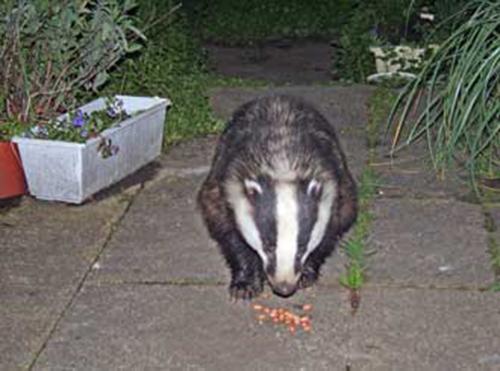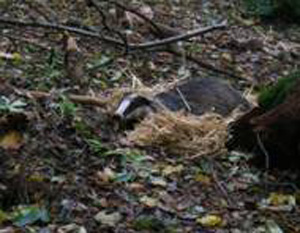ADVICE AND GUIDELINES
The following advice is based on the Badger Trust’s publication ‘Badgers in your Garden’.
The guidelines have been produced to help people who have a problem with badgers in their gardens. Many people are delighted and welcome badgers when they choose to visit. Occasionally, though, they damage gardens, particularly lawns and plants, to the disappointment and annoyance of the gardener. Badgers are strong animals and can damage fences and other boundaries in their determination to enter gardens.

BADGERS AND GARDENS
Badgers are creatures of habit, living in a social group (or family) which occupies a territory. This territory may include your garden, and depending on where you live, could include many neighbouring gardens and other sites, or surrounding fields and woods if you live in the country. The size of badger territories can vary considerably, with each one providing for all the needs of its resident badgers.
Quite often when new properties are built badgers are disturbed and may lose feeding grounds. This can result in badgers entering established gardens nearby which have not been troubled before. Also as new gardens are established badgers visit them as they form part of their original territory. Almost invariably badgers will enter gardens in search of food.
Badgers are normally nocturnal so garden visits are generally unseen during the night, unless the badgers’ sett is nearby when the animals may visit early in the evening. Badgers tend to follow the same routes when moving around their territory, so the entry point into your garden should be easy to find.
Occasionally an injured or sick badger may seek refuge in a garden and hide in an outbuilding or under a shed. Sometimes it can be seen during the day. If this happens or badgers start to excavate a sett in your garden, contact your local badger group or Badger Trust for advice. Food placed for other animals and birds, particularly peanuts, will attract badgers. To avoid this, food should only be placed in the garden during daylight and not left out overnight.


Badgers are omnivorous and will eat many things. Most of the time badgers search for earthworms and insect larvae, which are often easy to find in lawns with short grass. They will also eat flower bulbs, fruits and vegetables, with some items being favoured more than others. Quite often the seasonal availability of food will result in badger activity fluctuating with the time of year. The most obvious signs of badgers feeding are when they scrape out small pits in lawns to dig out insect larvae like cockchafer, cutworm and leatherjackets. Squirrels, woodpeckers, rooks and crows make similar holes. When badgers take earthworms there is often little trace as the badgers suck them up off the surface.
On occasion badgers will take other wild animals if available, such as rabbits, moles, rats, mice and hedgehogs. They will also take food put out for other animals, and occasionally raid dustbins.
In dry or frosty weather badgers are unable to get at their preferred earthworm and insect larvae food. Putting out food and water at these times specifically for the badgers may distract them from eating other food available, such as your fruit and vegetables. However, food placement may encourage the badgers to visit more frequently, which could be counterproductive if they are causing problems. Also it may artificially support a larger population of badgers than that which would occur naturally.
If you wish to feed badgers in your garden, they will readily eat peanuts, raisins, most soft fruits and bread (which can be soaked in water or spread with peanut butter). A specially formulated badger food is also available commercially from CJ WildBird Foods.
Sweet foods such as cakes, honey, jam and syrup are loved by badgers but can cause tooth decay and so should be given only as an occasional treat and then in very small quantities. Milk or meat scraps should not be fed to badgers.


Badgers could excavate a sett. Badgers are large animals up to a metre long and often weighing more than 12 kilograms. A badger sett would therefore be quite obvious by the amount of spoil removed during excavation, and by the size of the tunnels (250mm diameter).
Occasionally badgers may dig a latrine in your garden. A latrine is usually a small excavation flower pot sized – about 150mm deep and about as wide, in which the badgers deposit their dung. If your garden has an overgrown area with dense cover then badgers may make a nest in there. The collection of bedding material (grass, leaves or other plant material) will leave an obvious trail as the badgers drag it backwards into the cover. These nests will be used periodically when the badgers are moving around their territory.
It is recommended that you always seek advice before taking any action. The ESBPS have a lot of experience in dealing with problems caused by badgers. (See Contact Us)
The legislation in place to protect badgers and their setts from persecution needs to be clearly understood to avoid well intentioned but illegal action. You could for example block up the place where badgers get into your garden, but if this prevented a badger from getting to or from its sett, it could be an offence.

Badgers and their homes (setts) are protected by law, but lawful actions can usually be taken to resolve, or at least minimise problems, without harm to badgers or other animals.
These guidelines contain general practical advice and information. Readers are advised to seek further local advice before taking any action which, although considered innocent, may inadvertently result in badgers or their setts being illegally harmed or disturbed.
The ESBPS may be able to help you with advice but they cannot give practical help. However, the ESBPS can put you in touch with a Consultant who can examine your problem and give you a quotation for dealing with it – Contact Us